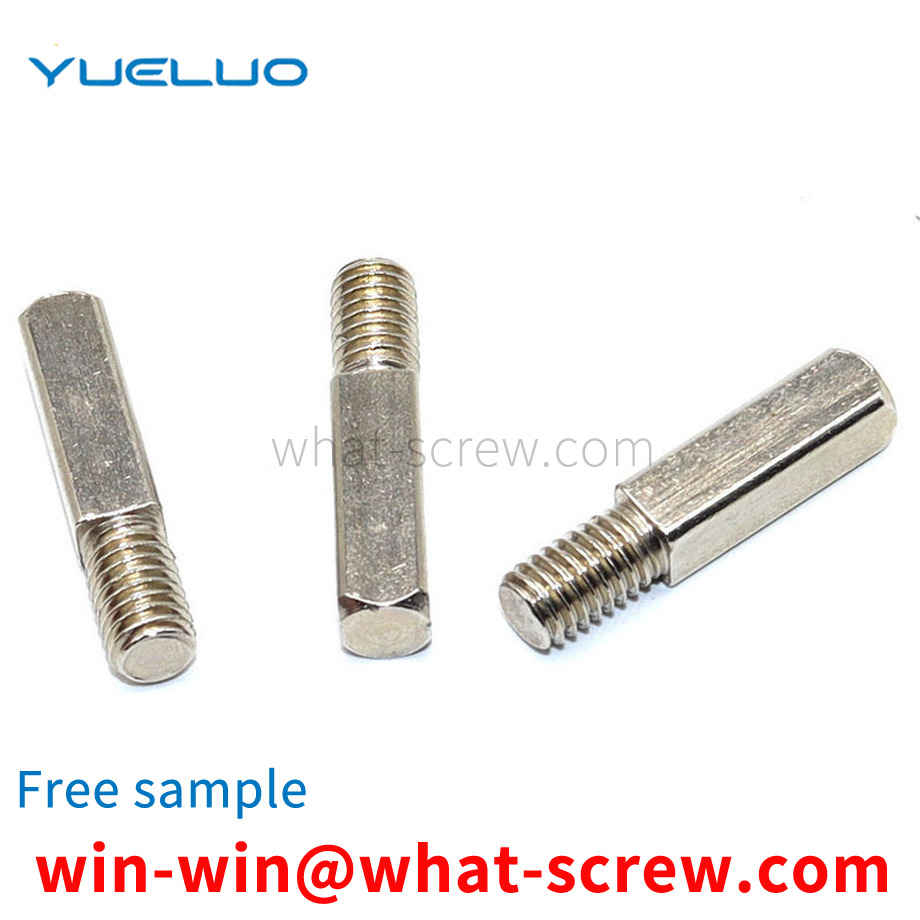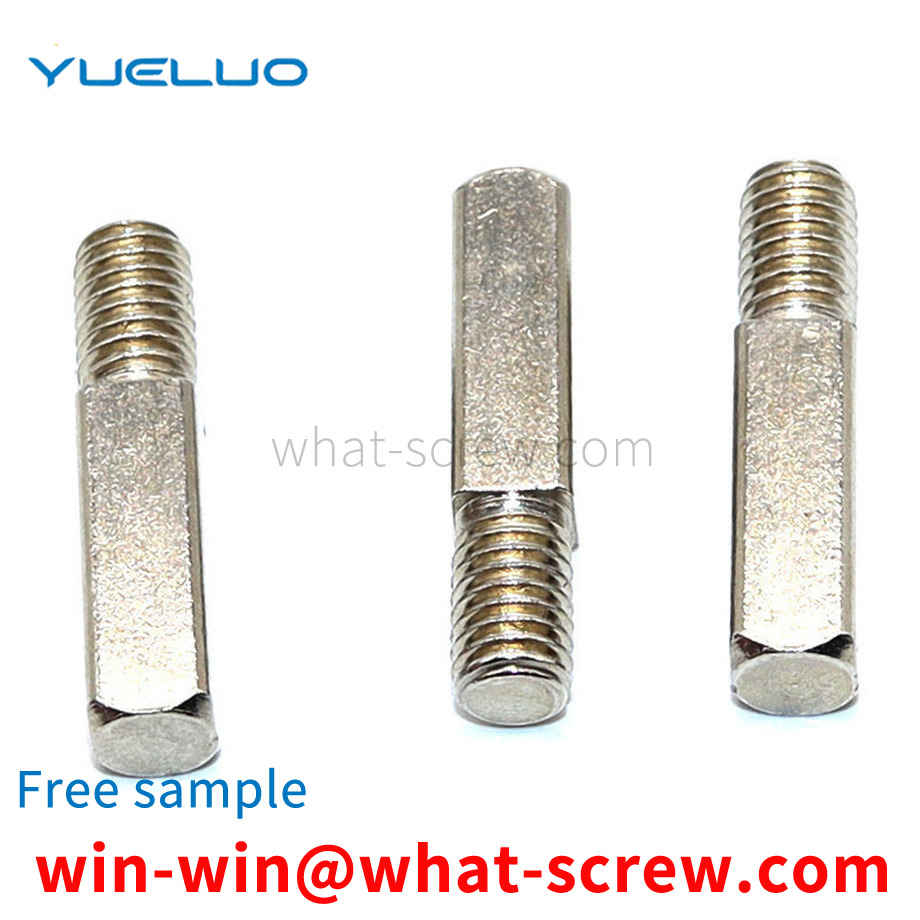In order to achieve the above purpose, Guangdong Yueluo Hardware Industry Co., Ltd. provides the following technical solutions: an anti-drop screw structure, including a connecting bolt and a fastening screw, the connecting bolt includes a connecting screw and a connecting nut, one end of the connecting screw It is integrally connected with the connecting nut, the surface of the connecting screw is provided with an external thread, the connecting bolt is movably mounted with a matching nut, the matching nut and the connecting bolt are connected by thread, and the interior of the connecting screw is provided There is a screw hole along the axis of the connecting screw. The connecting screw is provided with a number of slots along the axis. The slot extends into the screw hole. The screw hole is provided with an internal thread, and the screw hole is movable in the screw hole. A tightening screw is installed, the tightening screw includes a tightening screw and a tightening nut, one end of the tightening screw is integrally connected with the tightening nut, and the tightening screw is connected to the tightening nut through a screw hole Bolted thread connection.
As a standard part, it should have its own general specifications. For hexagonal nuts, the commonly used standards are: GB52, GB6170, GB6172 and DIN934. The main differences between them are: GB6170 is thicker than GB52, GB6172 and DIN934. Thick from DIN934, commonly known as thick nut. The other is the difference between the opposite sides, the opposite sides of DIN934, GB6170 and GB6172 in the M8 nut series are 13MM smaller than the opposite side 14MM of GB52, and the opposite sides of M10 nuts, DIN934 and GB52 are 17MM. The opposite side of GB6170 and GB6172 should be 1MM larger, M12 nut, DIN934, GB52's opposite side is 19MM larger than GB6170 and GB6172's opposite side 18MM is 1MM larger. For M14 nuts, the opposite side of DIN934 and GB52 is 22MM, which is 1MM larger than the opposite side of GB6170 and GB6172, which is 21MM. The other is the M22 nut. The opposite side of DIN934 and GB52 is 32MM, which is 2MM smaller than the opposite side of GB6170 and GB6172, which is 34MM. (Besides the thickness of GB6170 and GB6172 are the same, the width of the opposite side is exactly the same) The rest of the specifications can be used in general without considering the thickness.
The retaining ring is an industrial accessory that can function as support, buffering, braking, height adjustment and angle adjustment. The inner diameter of the retaining ring for the shaft is slightly smaller than the diameter of the assembly shaft. When the retaining ring for the hole is selected, the outer diameter of the retaining ring is slightly larger than the diameter of the assembly circular hole. The retaining ring mainly plays the role of axial fixation. The surface plus the retaining ring is fixed with a high degree of centering.
Friction type high-strength bolts: suitable for beam and column connections of steel frame structures, solid web beam connections, heavy-duty crane beam connections in industrial plants, braking systems and important structures bearing dynamic loads. Pressure-bearing high-strength bolts: Can be used for shear connections in statically loaded structures that allow a small amount of sliding or in members that are indirectly loaded with dynamic loads. Tensile high-strength bolts: When the bolts are in tension, the fatigue strength is low. Under the action of dynamic load, its bearing capacity is not easy to exceed 0.6P (P is the allowable axial force of the bolt). Therefore, it is only suitable for use under static load. Such as flange butt joints, T-joints, etc. of pressure members.
The quality of electroplating is measured primarily by its corrosion resistance, followed by appearance. Corrosion resistance is to imitate the working environment of the product, set it as the test condition, and perform a corrosion test on it. The quality of electroplating products shall be controlled from the following aspects: 1. Appearance: Partial uncoated, scorched, rough, gray, peeling, crusted, and obvious stripes are not allowed on the surface of the product, and pinholes, pitting, and black plating are not allowed. Slag, loose passivation film, cracks, peeling off and serious passivation marks. 2. Coating thickness: The operating life of fasteners in corrosive atmosphere is proportional to its coating thickness. The general recommended thickness of economical electroplating coating is 0.00015in ~ 0.0005in (4 ~ 12um). Hot-dip galvanizing: the standard average thickness is 54 um (43 um for diameter ≤ 3/8), and the minimum thickness is 43 um (37 um for diameter ≤ 3/8). 3. Coating distribution: With different deposition methods, the aggregation method of the coating on the surface of the fastener is also different. During electroplating, the coating metal is not uniformly deposited on the peripheral edge, and a thicker coating is obtained at the corners. In the threaded portion of the fastener, the thickest coating is located on the thread crest, gradually thinning along the flank of the thread, and the thinnest deposit is at the bottom of the thread, while hot dip galvanizing is just the opposite, the thicker coating is deposited on the inside corners and On the bottom of the thread, mechanical plating tends to deposit the same metal as hot-dip plating, but is smoother and has a much more uniform thickness over the entire surface [3]. 4. Hydrogen embrittlement: During the processing and processing of fasteners, especially in the pickling and alkali washing before plating and the subsequent electroplating process, the surface absorbs hydrogen atoms, and the deposited metal coating then traps hydrogen. When the fastener is tightened, the hydrogen is transferred towards the most stressed parts, causing the pressure to build up beyond the strength of the base metal and producing microscopic surface cracks. Hydrogen is particularly active and quickly seeps into the newly formed fissures. This pressure-rupture-penetration cycle continues until the fastener breaks. Usually occurs within a few hours after the first stress application. To eliminate the threat of hydrogen embrittlement, fasteners are heated and baked as soon as possible after plating to allow hydrogen to seep out of the plating, typically at 375-4000F (176-190C) for 3-24 hours. Since mechanical galvanizing is non-electrolyte, this virtually eliminates the threat of hydrogen embrittlement, which exists in galvanizing using electrochemical methods. In addition, due to engineering standards, it is forbidden to hot-dip galvanize fasteners with hardness higher than HRC35 (Imperial Gr8, metric 10.9 and above). Therefore, hydrogen embrittlement rarely occurs in hot-dip plated fasteners. 5. Adhesion: Cut or pry off with a solid tip and considerable pressure. If, in front of the blade tip, the coating peels off in flakes or skins, exposing the base metal, the adhesion shall be considered insufficient.
We have many years of experience in the production and sales of screws, nuts, flat washers, etc. The main products are: furniture plywood nuts, cross bolts and nuts, round head hexagon socket head bolts and nuts, full threaded bolts and other products, we can provide you with suitable tightening screws for you. Firmware Solutions.



















 Service Hotline
Service Hotline




